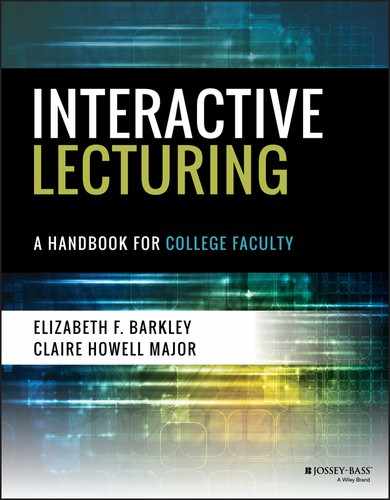ENGAGING LECTURE TIP 14
Aristotelian Triptych
The Aristotelian Triptych is simply this: tell them what you are going to tell them, tell them, and then tell them what you told them. This classic three-part approach is useful whenever you need to make a lecture presentation because it provides a simple, straightforward framework that helps students understand and then remember what you have said. It is particularly useful for demonstrating your mastery of the ideas and building a case for the information you have shared.
When deciding to use Aristotelian Triptych for a given lecture, or lecture segment, there are three phases:
- Tell them what you are going to tell them. In the opening segment, you describe why you are talking on this particular topic and why students will need it. You should consider two aspects: what you want to say and what the audience needs to hear. It is easy to focus on the first half and forget the second. Knowing what your students need to hear in order to engage with the message is critical to your message. You are there to provide them leadership, and, in this segment, you can.
- Tell them. This section is where you share the argument and general content of your presentation and explain the details. As a teacher, it is the best time for you to make a strong case for your message. Students will need to understand why what you're saying is important and how they will use the ideas and information.
- Tell them what you just told them. Here you reiterate the most salient points. This step basically involves providing a summary. For teachers, this is also an opportunity to give learners a reason to learn the materials. You can also invite students to tell you what you just told them. Consider some of our techniques in Part 3 of this book.
The Aristotelian Triptych is a formula for a presentation, and although some argue that it can make a presentation a boring one, it need not be formulaic if you use your content and engage your personality in the delivery.
Example
Key References and Resources
- Smith, K. A. (2000). Going deeper: Formal small-group learning in large classes. In J. MacGregor, J. L. Cooper, K. A. Smith, & P. Robinson (Eds.), New Directions for Teaching and Learning: Strategies for Energizing Large Classes; From Small Groups to Learning Communities, 81, 25–46.
- Smith, K. A., Sheppard, S. D., Johnson, D. W., & Johnson, R. T. (2005). Pedagogies of engagement: Classroom-based practices. Journal of Engineering Education, pp. 1–16.
- Tiscone, R. (2006). Aristotle's tried and true recipe for argument casserole. Retrieved from https://info.legalsolutions.thomsonreuters.com/pdf/perspec/2006-fall/2006-fall-9.pdf
